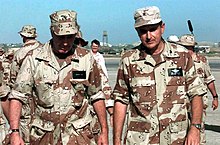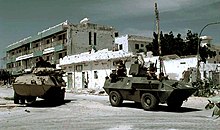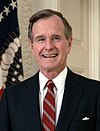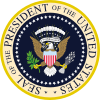Unified Task Force
| Operation Restore Hope | |||||||
|---|---|---|---|---|---|---|---|
| Part of the Somali Civil War | |||||||
| |||||||
| |||||||
| Participants | |||||||
|
Somali National Alliance Al-Itihaad al-Islamiya | |||||||
| Commanders and leaders | |||||||
|
Mohamed Farrah Aidid Hassan Dahir Aweys | |||||||
The Unified Task Force (UNITAF), also known as Operation Restore Hope, was a United States-led, United Nations-sanctioned multinational military force deployed to Somalia from 5 December 1992 to 4 May 1993. It was established to replace United Nations Operation in Somalia I (UNOSOM I), which had been deployed in April 1992 in response to the 1992 famine—a crisis that followed the 1991 collapse of the Somali Democratic Republic and the full outbreak of the Somali Civil War.
UNITAF was mandated to create a secure environment for humanitarian operations "by all necessary means". The task force, led by 28,000 US troops,[1] included international contributions from dozens of armed forces, totaling around 37,000 troops. Military deployments focused on the south, as central and northern Somalia remained relatively stable.[2] UNITAF forces began landing in Somalia during early December 1992, just as the famine was concluding.[3]
Aspects of the operation, in particular the large foreign military deployment, faced opposition from significant segments of Somali society and major factions such as the Somali National Alliance and Al-Itihaad al-Islamiya.[4][5]
In May 1993, UNITAF handed over its responsibilities to United Nations Operation in Somalia II (UNOSOM II), transitioning to a broader UN-led mission—though the operation effectively remained under US control.[6][7]
Background
[edit]During the 1980s, the Somali Rebellion intensified, eventually culminating in the outbreak of full-scale civil war in 1991, which led to the collapse of the Somali Democratic Republic. The following year, a famine emerged, driven by both a major drought and the serious fighting that engulfed the nation’s breadbasket in the southern regions.
Deployment of UN forces
[edit]Faced with a humanitarian disaster in Somalia, exacerbated by a complete breakdown in civil order, the United Nations created the UNOSOM I mission in April 1992. During July 1992 the first UN troops landed in Somalia, seven Pakistani military troops under the command of Brigadier-General Imtiaz Shaheen.[8] Some elements were actively opposing the UNOSOM intervention. Troops were shot at, aid ships attacked and prevented from docking, cargo aircraft were fired upon and aid agencies, public and private, were subject to threats, looting and extortion.[9]
In August 1992, UNOSOM I head Mohammed Sahnoun secured an agreement with Mohamed Farah Aidid and the Somali National Alliance (SNA) to allow 500 UN peacekeepers, with the condition that any further deployments required SNA approval. However, later that month, UN Secretary-General Boutros Ghali announced plans to expand UNOSOM to 3,500 troops without consultation, to the surprise of both Sahnoun and the SNA. According to Professor Stephen Hill, Sahnoun recognized this move would undermine his local support, as it was made “without consulting Somali leaders and community elders.” He attempted to delay the deployment but was overruled by UN headquarters.[10] The large-scale foreign intervention in late 1992 fueled nationalist opposition to international troops, strengthening support for Aidid’s SNA, which condemned the UN’s perceived colonial practices.[4] Somali Islamist factions such as Al-Itihaad Al-Islamiya also demonstrated hostility to a foreign military presence.[5]
The head of UNOSOM I, Mohammed Sahnoun, was replaced by an Ismat T. Kittani during November 1992. Kittani immediately adopted a confrontational stance ordered the deployments of UNOSOM troops in politically sensitive areas, sparking a security crisis with local Somali factions.[11] Kittani pushed claims that 80% of all aid shipments were being looted, which was later repeated by the UN Secretariat and the US State Department to justify expanding the scope of the intervention in Somalia. Alex de Waal observes that though the statistic was treated as fact by the Americans and UN, "its origins are untraceable." Doctors Without Borders noted that nobody on the ground could seriously claim that such a proportion was not getting through, while staff at various aid agencies operating in Somalia such as World Food Program, the Red Cross and CARE contested that real figures were far lower.[12] The head of UNOSOM I troops, Brigadier-General Imtiaz Shaheen of the Pakistani army, stated in an interview with British journalists that the amount of aid being looted was being exaggerated in order justify expanding the scope of the operation and that estimates of 80% were completely fabricated.[13]
Expansion of operation and American military intervention
[edit]The United Nations Secretariat believed Somalia represented an ideal candidate for a test case of a UN operation in expanded size and mandate.[14] In the view of some top UNOSOM I commanders, the scope of the famine in Somalia was being exaggerated in order to justify using Somalia as an experiment for "conflict resolution".[13] The United States had various motives for military involvement in Somalia. The US armed forces wanted to prove it's capability to conduct major 'Operations Other Than War', while the US State Department wanted to set a precedent for humanitarian military intervention in the post-Cold War era.[14] The Los Angeles Times reported that, shortly before the collapse of the Somali Democratic Republic in 1991, nearly two-thirds of the country had been allocated to American oil giants such as Conoco in deals with the government. Some observers in the petroleum industry and East African experts suggested that protecting these concessions played a factor in the decision to launch the operation.[15]
Following this recommendation, on 3 December 1992 the Security Council unanimously adopted Resolution 794, authorizing the use of "all necessary means to establish as soon as possible a secure environment for humanitarian relief operations in Somalia". The Security Council urged the Secretary-General and member states to make arrangements for "the unified command and control" of the military forces that would be involved.[16] UNITAF has been considered part of a larger state building initiative in Somalia, serving as the military arm to secure the distribution of humanitarian aid. However, UNITAF cannot be considered a state building initiative due to its specific, limited and palliative aims, which it nonetheless exercised forcefully. The primary objective of UNITAF was security rather than larger institution building initiatives.[17]
Composition
[edit]The vast bulk of UNITAF's total personnel strength was provided by the United States (some 25,000 out of a total of 37,000 personnel). Other countries that contributed to UNITAF were 1st Battalion, Royal Australian Regiment from Australia (January–May 1993), Bangladesh, Belgium, Botswana, Canada, Egypt (one battalion), Ethiopia, France (brigade HQ and one battalion), Germany, Greece (medical company at Waajid), the Indian Army (brigade HQ at Baidoa and three battalions), Ireland (transport company), Italy, Indonesia, Kuwait, Morocco, elements of No. 40 Squadron RNZAF from New Zealand, Nigeria, Norway, Pakistan, Saudi Arabia, Spain, Sweden, Tunisia, Turkey, United Arab Emirates, the United Kingdom, and Zimbabwe.[18]
The U.S. Central Command (USCINCCENT) established Joint Task Force (JTF) Somalia to perform Operation Restore Hope. The I Marine Expeditionary Force (I MEF) staff made up the core of the JTF headquarters. (The name of this command started as CJTF Somalia but changed to United Task Force-UNITAF). The CJTF commanded Marine forces from I MEF (referred to as MARFOR Somalia) and Army forces from the
10th Mountain Division (referred to as ARFOR Somalia), as well as Air Force and Navy personnel and units.[19] There were also special operations forces components, in addition to the forces provided by countries contributing to the US-led, combined coalition.

The national contingents were co-ordinated and overseen by U.S. Central Command, however, the relationship between CentCom and the contributing nations varied. There were a few confrontations over the methods and mandates employed by some contingents. For example, the Italian contingent was accused of bribing local militias to maintain peace, whilst the French Foreign Legion troops were accused of over-vigorous use of force in disarming militiamen.[20] The Canadian contingent of the operation was known by the Canadian operation name Operation Deliverance.
"The deck was stacked against UNOSOM II, to some extent, from the beginning. The US was anxious to leave, feeling they had accomplished their somewhat limited objectives, but the UN was far from ready to receive the baton. The US, which had planned for a five or six weeks mission when it agreed to head UNITAF, was ready to turn over the command by mid-January. As the UNITAF commander was able to assign humanitarian relief sectors (HRS) to non-US forces, he began—with the approval of CINCCENT and the JCS—to reduce US forces and redeploy them to their home bases. In his words, Lieutenant General Robert B. Johnston [commander I MEF] “knew his mission had been accomplished” and was waiting for the UN to assume the greater mission formally. However, United Nations Security Council Resolution 814 authorizing UNOSOM II was not passed until late March, and the first staff members were not in place and ready to start the transition until April."[21]
United States
[edit]
Prior to Resolution 794, the United States had approached the UN and offered a significant troop contribution to Somalia, with the caveat that these personnel would not be commanded by the UN. Resolution 794 did not specifically identify the U.S. as being responsible for the future task force, but mentioned "the offer by a Member State described in the Secretary-General's letter to the Council of 29 November 1992 (S/24868) concerning the establishment of an operation to create such a secure environment".[22] Resolution 794 was unanimously adopted by the United Nations Security Council on 3 December 1992, and they welcomed the United States offer to help create a secure environment for humanitarian efforts in Somalia.[23] President George H. W. Bush responded to this by initiating Operation Restore Hope on 4 December 1992, under which the United States would assume command in accordance with Resolution 794.[24]
Operation
[edit]
The operation began on 6 December 1992, when Navy SEALs and special warfare combatant-craft crewmen from Naval Special Warfare Task Unit TRIPOLI began conducting beach and port hydrographic and reconnaissance survey operations in the vicinity of the landing beach, airport, and harbor. These operations lasted three days. In the early hours of 8 December 1992, elements of the 4th Psychological Operations Group attached to the 15th Marine Expeditionary Unit (MEU) conducted leaflet drops over the capital city of Mogadishu.[25][26]
Deployment
[edit]On 9 December 1992, American troops began landing on the Somali coastline at Mogadishu. A total 17,800 US Marines and 10,000 US Army infantry were deployed.[27] The famine in Somalia was already abating as the troops began landing.[3]
Mohamed Farah Aidid, leader of the Somali National Alliance (SNA), initially welcomed the operation, reportedly at the urging of his lieutenant Osman Atto, who had close ties to U.S. embassy officials in Nairobi and the American oil company Conoco. Aidid favored a U.S.-led mission over a UN-led one, given his strained relationship with the UN Secretary-General Boutros-Ghali. Regardless the SNA and other factions lacked the military capability to resist the landings had they wanted to. This non-confrontational stance was reciprocated by the Americans who initially avoided trying to disarm Aidid's faction. American diplomat Robert B. Oakley and US Marine General Robert Johnson made clear in public statements that the intentions of US troops were 'strictly humanitarian' and that their forces would only use force to protect themselves or aid convoys.[27]
Concurrently, various Somali factions returned to the negotiating table in an attempt to end the civil war. This effort was known as the Conference on National Reconciliation in Somalia and it resulted in the Addis Ababa Agreement signed on 27 March 1993.[28] The conference, however, had little result as the civil war continued afterwards.
Results
[edit]As UNITAF's mandate was to protect the delivery of food and other humanitarian aid, the operation was regarded as a success.[29] United Nations Secretary-General Boutros Boutros-Ghali determined that the presence of UNITAF troops had a "positive impact on the security situation in Somalia and on the effective delivery of humanitarian assistance."[30] An epidemiological survey determined approximately 10,000 lives had been saved by the military intervention. While UNITAF saw a dramatic increase in the scope of the military intervention, no more lives were saved compared to UNOSOM I. The primary reason was due to the sharp decline in mortality rates during October 1992, before the large scale deployment of troops. Studies on the intervention noted that UNITAF had the effect of speeding up the famines conclusion by about a month.[31] According to an assessment by the Washington based independent NGO Refugee Policy Group, only 10,000 to 25,000 lives of the approximately 100,000 rescued by international assistance had been saved by the UNITAF and UNOSOM II interventions, and according to Professor Alex de Waal the true figure may have been even lower.[32][33] Figures like Secretary-General Boutros-Ghali and American diplomat Chester Crocker claimed that the intervention saved a quarter of a million Somali lives,[34] a claim which has been disputed by other observers who have noted that there is minimal evidence to suggest that UNITAF had had any significant impact on mortality.[31]
No disarmament of the rivalling factions within Somalia was undertaken.[35] This meant that the situation stayed stable only for the time UNITAF's overwhelming presence was deterring the fighting. Therefore, the mandate to create a "secure environment" was not achieved in a durable fashion. The Canadian Airborne Regiment was disbanded due to its conduct at UNITAF that was revealed during an investigation into the Somalia Affair.[citation needed]
Transition to UNOSOM II
[edit]UNITAF was only intended as a transitional body.[citation needed] Once a secure environment had been restored, the suspended UNOSOM mission would be revived, albeit in a much more robust form. On 3 March 1993, the Secretary-General submitted to the Security Council his recommendations for effecting the transition from UNITAF to UNOSOM II. He noted that despite the size of the UNITAF mission, a secure environment was not yet established and there was still no effective functioning government or local security/police force.[9] The Secretary-General concluded therefore, that, should the Security Council determine that the time had come for the transition from UNITAF to UNOSOM II, the latter should be endowed with enforcement powers under Chapter VII of the United Nations Charter to establish a secure environment throughout Somalia.[9] The operation would therefore seek to complete the task begun by UNITAF for the restoration of peace and stability in Somalia. The new mandate would also empower UNOSOM II to assist the Somali people in rebuilding their economic, political and social life, through achieving national reconciliation so as to recreate a democratic Somali State.[citation needed] UNOSOM II was established by the Security Council in Resolution 814 on 26 March 1993 and formally took over two months later.[36]
One day prior to the signing of the Addis Ababa Agreement, the United Nations Security Council passed Resolution 814, which marked the transfer of power from UNITAF to UNOSOM II, a United Nations led force. The major change in policy that the transition from UNITAF to UNOSOM II entailed is that the new mandate included the responsibility of nation-building on the multinational force.[37]
On 3 May 1993, UNOSOM II officially assumed command, and on 4 May 1993 it assumed responsibility for the operations. Despite UNOSOM II being composed of a coalition of twenty-seven countries, most of the decision makers were still Americans, giving the United States significant control over much of the operation.[38][39] Marine Lt. Gen. Robert B. Johnston, head of UNITAF, would state that although in his view UNITAF had been success US efforts and losses would be in vain if UNOSOM II was also not successful.[39] UNOSOM II Force Commander Cevik Bir openly admitted that the critical posts in his headquarters were manned by Americans by May 1993,[39] and it was observed that very few nations involved had any representation in the UN military command structure.[38][40] In addition to this the representative of the UN Secretary-General in Somalia and head of UNOSOM II, retired US Admiral Jonathan Howe, staffed his headquarters with twenty-eight US officers in key positions. Months into the operation, following the 5 June 1993 killings of the Pakistanis and the passing of UNSCR 837, the US would effectively take lead of the mission.[38]
References
[edit]Footnotes
[edit]- ^ Drysdale 1994, pp. 84–85.
- ^ Drysdale 1994, pp. 104–105.
- ^ a b de Waal 1997, p. 185.
- ^ a b Maynes, C. William (Charles William); Williamson, Richard S.; American Assembly (1996). U.S. Foreign policy and the United Nations system. Internet Archive. New York : W.W. Norton. p. 65. ISBN 978-0-393-03907-8.
- ^ a b Noble, Kenneth B. (15 January 1993). "Islamic Militants, Pushed Aside, Express Anger in Somali Port". The New York Times. ISSN 0362-4331. Retrieved 9 February 2025.
- ^ Berdal, Mats R. (1994). "Fateful Encounter: The United States and UN peacekeeping". Survival: Global Politics and Strategy. 36 (1): 30–50. doi:10.1080/00396339408442722. ISSN 0039-6338.
- ^ Peterson, Scott (25 May 1993). "US Backs Up UN in Somalia, Protecting Its Investment". Christian Science Monitor. ISSN 0882-7729. Retrieved 17 May 2023.
- ^ Drysdale 1994, p. 52-53.
- ^ a b c "United Nations Operation In Somalia I – (Unosom I)". Un.org. Retrieved 29 January 2012.
- ^ Hill, Stephen M. (2005). United Nations Disarmament Processes in Intra-State Conflict (PDF). Palgrave Macmillan. pp. 93–94. doi:10.1057/9780230502963_4. ISBN 978-0-333-94716-6. OCLC 885487671. Archived (PDF) from the original on 22 May 2024. Retrieved 29 March 2023.
- ^ de Waal 1997, p. 181.
- ^ de Waal 1997, p. 183.
- ^ a b Huband, Mark. The Skull Beneath the Skin: Africa after the Cold War. Westview. p. 294. ISBN 978-0813341125.
- ^ a b de Waal 1997, p. 179.
- ^ Fineman, Mark (18 January 1993). "The Oil Factor In Somalia: Four American Petroleum Giants Had Agreements With The African Nation Before Its Civil War Began". Los Angeles Times.
- ^ United Nations, Security Council resolution 794 (1992), 24 April 1992, para. 3
- ^ Caplan, Richard (2012). Exit Strategies and State Building. New York: Oxford University Press. p. 86. ISBN 978-0199760121.
- ^ "UNITED NATIONS OPERATION IN SOMALIA II (UNOSOM II) - Background (Summary)". peacekeeping.un.org. Retrieved 16 September 2021.; Ramsbothan and Woodhouse, 1999, 225.
- ^ Relations with Humanitarian Relief Organizations: Observations from Restore Hope, Center for Naval Analysis
- ^ Patman, R.G., 2001, ‘Beyond ‘the Mogadishu Line’: Some Australian Lessons for Managing Intra-State Conflicts’, Small Wars and Insurgencies, Vol, 12, No. 1, p. 69
- ^ Bullock 1995, https://www.airuniversity.af.edu/AUPress/SAASS-Theses/smdpage15021/6/
- ^ "Security Council resolutions – 1992". Un.org. Retrieved 29 January 2012.
- ^ Security Council Resolution 794
- ^ Bush, George H., Address to the Nation on the Situation in Somalia, 4/12/92 On 23 December 1992,
- ^ Friedman, Herbert A. "United States PSYOP in Somalia". Psywarrior. Retrieved 2 December 2012.
- ^ Borchini, Charles P. (Lt. Col.); Borstelmann, Mari (October 1994). "PSYOP in Somalia: The Voice of Hope" (PDF). Special Warfare. United States Army. Retrieved 2 December 2012.[permanent dead link]
- ^ a b Drysdale 1994, pp. 86–89.
- ^ "The General Agreement signed in Addis Ababa on 8 January 1993". United States Institute of Peace. Archived from the original on 29 December 2006. Retrieved 30 November 2019.
- ^ "Operation Restore Hope". Globalsecurity.org. Retrieved 2 December 2007.
- ^ "United Nations Operation in Somalia I". Retrieved 2 December 2007.
- ^ a b Seybolt, Taylor B. (2012). Humanitarian military intervention: the conditions for success and failure (PDF) (Repr ed.). Solna, Sweden: Sipri, Stockholm International Peace Research Inst. pp. 56–57. ISBN 978-0-19-955105-7.
- ^ Maren, Michael (1997). The Road to Hell. Free Press. p. 214. ISBN 978-0-7432-2786-5.
- ^ Funk, Kevin (2009). Scramble for Africa : Darfur-intervention and the USA. Black Rose Books. p. 71. OCLC 1342130779.
- ^ Crocker, Chester A. (1995). "The Lessons of Somalia: Not Everything Went Wrong". Foreign Affairs. 74 (3): 2–8. doi:10.2307/20047117. ISSN 0015-7120. JSTOR 20047117.
- ^ Norrie MacQueen (2006). Peacekeeping and the International System. Routledge.[ISBN missing]
- ^ Brune, Lester H. (1998). The United States and Post-cold War Interventions: Bush and Clinton in Somalia, Haiti, and Bosnia, 1992–1998. Regina Books. p. 33. ISBN 978-0941690904.
- ^ "United Nations Operation in Somalia 2". Un.org. Retrieved 2 December 2007.
- ^ a b c Berdal, Mats R. (1994). "Fateful Encounter: The United States and UN peacekeeping". Survival: Global Politics and Strategy. 36 (1): 30–50. doi:10.1080/00396339408442722. ISSN 0039-6338.
- ^ a b c "US Backs Up UN in Somalia, Protecting Its Investment". Christian Science Monitor. 25 May 1993. ISSN 0882-7729. Retrieved 17 May 2023.
- ^ Bradbury, Mark (1994). The Somali Conflict: Prospects for Peace. Oxfam. ISBN 0-85598-271-3.
Bibliography
[edit]- Drysdale, John (1994). Whatever Happened to Somalia? A Tale of Tragic Blunders. London: HAAN. ISBN 1-874209-51-0. OCLC 30736422.
- de Waal, Alex (1997). Famine Crimes: Politics & the Disaster Relief Industry in Africa. Britain: Indiana University Press. ISBN 0-253-21158-1. OCLC 37261123.
- Peterson, Scott (2000). Me Against My Brother: At War in Somalia, Sudan, and Rwanda: A Journalist Reports From the Battlefields of Africa. New York: Routledge. ISBN 9780415921985. OCLC 43287853.
- Allard, Kenneth (1995). Somalia Operations : Lessons Learned (PDF). Washington, DC: National Defense University Press. ISBN 978-0160455773. OCLC 32155661. Archived from the original (PDF) on 8 August 2022.
- Harned, Glenn M. (2016). Stability Operations in Somalia 1992-1993 : A Case Study (PDF). Carlisle Barracks, PA: United States Army War College: Peacekeeping and Stability Operations Institute. ISBN 978-0-9861865-8-5. Archived from the original (PDF) on 17 April 2018. Retrieved 8 August 2022.
- Miller, Laura L.; Moskos, C. (1995). "Humanitarians or Warriors?: Race, Gender, and Combat Status in Operation Restore Hope". Armed Forces & Society. 21 (4): 615–637. doi:10.1177/0095327x9502100406. S2CID 144654522.
- Poole, Walter S. (2005). "The Effort to Save Somalia August 1992-March 1994" (PDF). Joint History Office of Joint Chiefs of Staff. Archived from the original (PDF) on 29 May 2022. Retrieved 7 August 2022.
- Stevenson, Jonathan (1995). Losing Mogadishu: Testing U.S. Policy in Somalia. Annapolis, MD: Naval Institute Press. ISBN 978-1557507884.
- Stewart, Richard W. (2003). "The United States Army in Somalia 1992-1994". United States Army Center of Military History. Archived from the original on 19 June 2022. Retrieved 6 August 2022.
- The United Nations and Somalia 1992-1996. The United Nations Blue Book Series. Vol. VIII. New York, NY: United Nations Department of Public Information. 1996. ISBN 978-92-1-100566-0. Archived from the original on 8 August 2022. Retrieved 8 August 2022.
- "United States Forces, Somalia After Action Report and Historical Overview: The United States Army in Somalia, 1992–1994" (PDF). United States Army Center of Military History. 2003. Archived from the original (PDF) on 1 August 2022. Retrieved 7 August 2022.
External links
[edit]- Battles involving Botswana
- Humanitarian military operations
- Military operations involving Australia
- Military operations involving Belgium
- Military operations involving India
- Military operations involving Italy
- Military operations involving Malaysia
- Military operations involving New Zealand
- Military operations involving Pakistan
- Military operations involving the United Kingdom
- Military operations involving the United States
- Pakistan military presence in other countries
- Military operations of the Somali Civil War
- Somalia–United States relations
- United Nations operations in Somalia
- United Nations Security Council subsidiary organs
- United States Marine Corps in the 20th century







